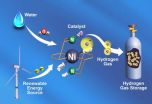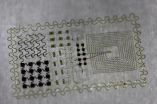(Press-News.org) Bacteria may have bad reputations but in fact, all animals -- us included -- rely on them in critical ways. In the case of sap-feeding insects, intimate associations with microbes offer a source for essential nutrients that their sugary diets just don't include. Now, researchers reporting in the August 11th Current Biology, a Cell Press publication, have new insight into organisms that have taken this symbiotic lifestyle to the extreme; they have sequenced the genomes of two species of bacteria that live together, one inside of the other, inside mealybugs.
The effort has revealed a level of molecular-level integration between bacterial species that scientists have never before seen.
"This symbiosis teaches us a lot about extremes," said John McCutcheon of the University of Montana. "The mealybug, Tremblaya and Moranella represent an extreme level of integration between organisms, each requiring fragments of essential amino acid pathways from the other to survive."
Scientists first discovered the bacteria living within mealybugs in the mid-1900s, but at that time they were thought to be a single species. More recently, scientists confirmed that there were in fact two endosymbionts in the mealybugs. That those bacteria, Tremblaya and Moranella, were in fact nested one inside the other came to light only much more recently, based on the discovery of study co-author Carol von Dohlen of Utah State University.
McCutcheon and his colleagues had studied other examples of dual symbionts living within insects before, and their genomes had shown remarkable levels of metabolic complementarity. For example, he says, one bacterial partner might make eight of the ten essential amino acids, leaving the other to make the remaining two.
The nested organization of the mealybug symbionts made them an irresistible choice for further exploration. "We hoped to learn if and how the duties of nutrient production were distributed between the two symbionts," McCutcheon said. "Frankly, we thought that the system was so cool and unique that we just had to do it. It just had to be interesting!"
And indeed, it is. As in previous examples, the bacterial genomes have each lost genes such that they now show little overlap in retained genes involved in nutrient production. But, in this instance, several of the amino acid pathways apparently require a patchwork of interspersed gene products from Tremblaya, Moranella, and possibly the mealybug too.
McCutcheon and von Dohlen don't yet know quite how it works, but it suggests that metabolites or enzymes or both must get traded back and forth among species in order to come up with the complete set of essential amino acids needed by all three organisms.
Also notable, the researchers found that Tremblaya's genome has shrunk to an impressive degree, making its genome the smallest ever described in any cell.
"Tremblaya has undergone a massive amount of genome decay," McCutcheon said. "It shows how much reduction is possible in bacterial genomes, given the right permissive environment."
The mealybugs and their symbionts may be unusual, but the new findings hold important life lessons nonetheless. "These results really represent one extreme example, but the symbiosis theme replays itself over and over again in biology at many different levels," McCutcheon says.
### END
For bugs within bugs within mealybugs, life is a 'patchwork'
2011-08-12
ELSE PRESS RELEASES FROM THIS DATE:
Catalyst that makes hydrogen gas breaks speed record
2011-08-12
RICHLAND, Wash. -- Looking to nature for their muse, researchers have used a common protein to guide the design of a material that can make energy-storing hydrogen gas. The synthetic material works 10 times faster than the original protein found in water-dwelling microbes, the researchers report in the August 12 issue of the journal Science, clocking in at 100,000 molecules of hydrogen gas every second.
This step is just one part of a series of reactions to split water and make hydrogen gas, but the researchers say the result shows they can learn from nature how to control ...
Stick-on tattoos go electric
2011-08-12
VIDEO:
The video describes the new epidermal electronics system and shows how it is applied to the skin.
Click here for more information.
Through a combination of careful theoretical modeling and precise micro-manufacturing, a team of engineers and scientists has developed a new type of ultra-thin, self-adhesive electronics device that can effectively measure data about the human heart, brain waves and muscle activity – all without the use of bulky equipment, conductive ...
URALCHEM HOLDING P.L.C. Reports The First Half Of Year 2011 Unaudited IFRS Financial Results
2011-08-12
- Revenue increased to US $ 1.035 billion, compared to US $ 663 million
in H1 2010
- Operating profit increased to US $ 288 million, compared to US $ 83 million
in H1 2010
- Adjusted EBITDA grew to US $ 337 million, compared to US $ 137 million
in H1 2010
- Net profit amounted to US $ 244 million, compared to net loss of US $ 13 million in H1 2010
URALCHEM Holding P.L.C. (hereinafter URALCHEM Holding or the Company), a Cypriot holding company of the URALCHEM Group (hereinafter called the Group), one of the largest producers of nitrogen and phosphate fertilisers ...
Smart skin: Electronics that stick and stretch like a temporary tattoo
2011-08-12
VIDEO:
A new form of electronics, small enough to fit under a temporary tattoo, changes the way scientists think about gathering data from the human body.
Click here for more information.
CHAMPAIGN, Ill. — Engineers have developed a device platform that combines electronic components for sensing, medical diagnostics, communications and human-machine interfaces, all on an ultrathin skin-like patch that mounts directly onto the skin with the ease, flexibility and comfort of ...
Natural History Museum of Los Angeles County makes scientific history with 'pregnant plesiosaur'
2011-08-12
August 7, 2011 – A paper to be published on August 12, 2011 in the authoritative magazine Science reveals that Dr. F. Robin O'Keefe of Marshall University in Huntington, W.Va. and Dr. Luis Chiappe, Director of the Natural History Museum's Dinosaur Institute, have determined that a unique specimen now displayed in NHM's Dinosaur Hall is the fossil of an embryonic marine reptile contained within the fossil of its mother.
The 78-million-year-old, 15.4-foot-long adult specimen is a Polycotylus latippinus, one of the giant, carnivorous, four-flippered reptiles known as plesiosaurs ...
NIH-led team maps route for eliciting HIV-neutralizing antibodies
2011-08-12
Researchers have traced in detail how certain powerful HIV neutralizing antibodies evolve, a finding that generates vital clues to guide the design of a preventive HIV vaccine, according to a study appearing in Science Express this week. The discoveries were made by a team led by the Vaccine Research Center (VRC) at the National Institute of Allergy and Infectious Diseases (NIAID), part of the National Institutes of Health.
"This elegant research brings us another step closer to an HIV vaccine and establishes a potent new technique for evaluating the human immune response ...
Supernovae parents found
2011-08-12
Pasadena, CA— Type Ia supernovae are violent stellar explosions whose brightness is used to determine distances in the universe. Observing these objects to billions of light years away has led to the discovery that the universe is expanding at an accelerating rate, the foundation for the notion of dark energy. Although all Type Ia supernovae appear to be very similar, astronomers do not know for certain how the explosions take place and whether they all share the same origin. Now, a team of researchers has examined new and detailed observations of 41 of these objects and ...
Depression linked to increased risk of stroke in women
2011-08-12
Depressed women may face an increased risk of stroke, according to new research reported in Stroke: Journal of the American Heart Association.
In six years of follow-up of women in the Nurses' Health Study, researchers found that a history of depression was associated with a 29 percent increased risk of total stroke – even after considering other stroke risk factors. Women who used anti-depressant medication — particularly selective serotonin reuptake inhibitors— had a 39 percent increased risk of stroke. Examples of these drugs are Prozac, Zoloft, and Celexa.
Anti-depressant ...
Hidden soil fungus, now revealed, is in a class all its own
2011-08-12
ANN ARBOR, Mich.---A type of fungus that's been lurking underground for millions of years, previously known to science only through its DNA, has been cultured, photographed, named and assigned a place on the tree of life.
Researchers say it represents an entirely new class of fungi: the Archaeorhizomycetes. Like the discovery of a weird type of aquatic fungus that made headlines a few months ago, this finding offers a glimpse at the rich diversity of microorganisms that share our world but remain hidden from view.
The fungal phenomenon, brought to light by researchers ...
Bilayer graphene: Another step toward graphene electronics
2011-08-12
The Nobel Prize winning scientists Professor Andre Geim and Professor Kostya Novoselov have taken a huge step forward in studying the wonder material graphene and revealing its exciting electronic properties for future electronic applications.
Writing in the journal Science, the academics, who discovered the world's thinnest material at The University of Manchester in 2004, have revealed more about the electronic properties of its slightly fatter cousin – bilayer graphene.
The researchers, from the universities of Manchester, Lancaster (UK), Nijmegen (the Netherland) ...

